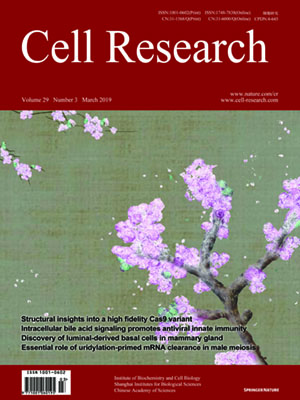
Volume 29, No 3, Mar 2019
ISSN: 1001-0602
EISSN: 1748-7838 2018
impact factor 17.848*
(Clarivate Analytics, 2019)
Volume 29 Issue 3, March 2019: 251-253
LETTERS TO THE EDITOR
Architecture of type VI secretion system membrane core complex
Meng Yin 1,2,3, Zhaofeng Yan 1,2,3 and Xueming Li 1,2,3,4
1Key Laboratory of Protein Sciences (Tsinghua University), Ministry of Education, Beijing, China; 2School of Life Sciences, Tsinghua University, Beijing, China; 3Advanced Innovation Center for Structural Biology, Tsinghua University, Beijing, China and 4Tsinghua-Peking Joint Center for Life Sciences, Beijing, China
These authors contributed equally: Meng Yin and Zhaofeng Yan.
Correspondence: Xueming Li (lixueming@tsinghua.edu.cn)
Dear Editor,
Type VI secretion system (T6SS) adopts a contact-dependent secretion mechanism to deliver various lethal effectors into prokaryotic or eukaryotic cells.1,2 Due to its antibacterial and anti-eukaryotic activity, T6SS provides a powerful weapon for bacteria to kill their competitors and attackers.2 T6SS has been shown to resemble a bacteriophage tail-like nanomachine of more than 13 components.3 The whole complex can be divided into four subassemblies: a membrane core complex of TssJLM (TssJ, TssL, and TssM), a baseplate of TssAEGFK (TssA, TssE, TssG, TssF, and TssK) with VgrG spike complex, a tail complex composed of the Hcp tube and TssBC (TssB and TssC) sheath, and a cytoplasmic ATPase ClpV.4 The membrane core complex serves as a docking station for the baseplate and also a channel for the passage of the Hcp tube after sheath contraction, and it is made up of the inner membrane proteins TssL and TssM, and the outer membrane lipoprotein TssJ.2,5 Partial structural information of the T6SS membrane core complex has been reported in recent years,2,6,7 including the crystal structures of TssJ, a part of TssL and TssM, and a low-resolution negative-staining electron microscopy (EM) structure of the whole complex. This structural information has revealed that the T6SS membrane core complex does not form a pore on the outer membrane as other secretion channels do, such as T2SS and T3SS.8,9 More precise structural information of the T6SS membrane core complex is necessary to understand the secretion through T6SS.
https://doi.org/10.1038/s41422-018-0130-7
FULL TEXT | PDF
Browse 1292


